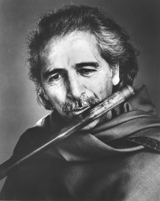 |
g. s. sachdev Sachdev performs the classical music of India, a culture
with a two thousand year musical tradition. Western
listeners accustomed to harmony initially may be deceived
by the apparent simplicity of this melodic music. The
complexities lie in the subtle variations on the theme,
ornamentation of notes, modal coloring, and in the interplay
between flute and drums. Since each note stands alone,
special care is given to the purity of intonation.
Sachdev performs the classical music of India, a culture
with a two thousand year musical tradition. Western
listeners accustomed to harmony initially may be deceived
by the apparent simplicity of this melodic music. The
complexities lie in the subtle variations on the theme,
ornamentation of notes, modal coloring, and in the interplay
between flute and drums. Since each note stands alone,
special care is given to the purity of intonation.
The basis of North Indian music is raga, the melodic form, and tala, the time measure. Thousands of ragas exist, each based on one of ten parent scales. Various ragas are associated with morning, afternoon, and evening, as well as with difference seasons. Beyond the melodic form, each raga encompasses a particular mood and synthesis of emotions which a skillful musician like Sachdev evokes. Improvisation plays an essential part, but always within the established framework of the ragawhich is being expressed. Indian music has a highly developed rhythmic system known as tala. Tala denotes an organized rhythmic cycle, composed of various rhythmic units, ranging from three to one hundred and eight beats. All Indian classical music is rooted in the vocal tradition, and the flute is regarded as being especially close to the voice, capable of the many subtle nuances of the vocal style.
Bansuri (bans-bamboo, swar-musical note) is a bass flute made of bamboo with seven open fingerholes. There are no keys to produce sharps and flats, but all the half and quarter tones are produced by carefully opening a small portion of the hole with the finger. The flute is one of the oldest instruments in existence. The bansuri has a three-octave range. Tabla is a two–piece drum set. The shell of the treble drum is made of wood, and the larger bass drum is made of metal, both with goatskin heads. The tanpura is a fretless, long–necked gourd, an the swar–peti is a small box with brass reeds and bellows. The drones create atmosphere and register the tonic in the minds of the listener and the performer.
Sachdev devotes most of his time to performing. his frequent European, Asian and American concert tours and numerous recordsing ahve brought him into international prominence as an outstanding classical musician. He holds a degree in music and is an articulate spokesman for the music of India, conducting master classes, workshops and lecture-demonstrations at the university level. His teaching, radio broadcasts and programs through Young Audiences of the Bay Area have made a large contribution to the growing awareness in the West of classical Indian music. Forty years endeavor has resulted in both purity of tone and subtleties of rhythm. He brings to the ancient, classical form his own creative improvisations. There is a depth and structure in his music that is indefinable but which reaches to the heart. Sachdev is on the Roster of Western Arts Foundation Performamce Tours Grant of 13 Western States and the California Arts Council Touring Program. He is also a Recipient of Billboard Magazine's Top Ten & Music Awards Album of the Year. Originally from Chandigarh, India, Sachdev currently makes his home in California. "...haunting performance...the sound of his flute rings with an indescribable purity" The New York Times "...Sachdev is one of those great artists you don't know how to describe because there are hardly any words. 'Marvelous' won't quite do. His playing defines what simplicity and beauty are." San Francisco Chronicle "...a model of imagination that never seemed forced." El Pais, Madrid "...an instinct for perfection." Times of India "The music of G.S. Sachdev separates people into the privacy of their own spirits." Oregon Daily Emerald "We are fortunate to have such a fine musician as Sachdev in our presence." George Harrison "I feel happy to see him blossom into a wonderful flutist. I admire his ability to touch the spirit of the raga he performs and also to move the listeners emotionally with his pure and classical approach." Ravi Shankar |
 |